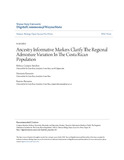Mostrar el registro sencillo del ítem
Ancestry Informative Markers Clarify the Regional Admixture Variation in the Costa Rican Population
| dc.creator | Campos Sánchez, Rebeca | |
| dc.creator | Raventós Vorst, Henriette | |
| dc.creator | Barrantes Mesén, Ramiro | |
| dc.date.accessioned | 2014-02-28T22:05:54Z | |
| dc.date.available | 2014-02-28T22:05:54Z | |
| dc.date.issued | 2013-10-09 | |
| dc.identifier.citation | http://digitalcommons.wayne.edu/humbiol/ | |
| dc.identifier.uri | https://hdl.handle.net/10669/9190 | |
| dc.description | artículo (arbitrado). Universidad de Costa Rica, Centro de Investigación en Biología Celular y Molecular, 2013 | es |
| dc.description.abstract | Study for the first time a random sample from all regions of the country with AIMS (Ancestry Informative Markers) to address the individual and regional admixture proportions. A sample of 160 male individuals was screened for 78 AIMs customized in a GoldenGate platform from Illumina. The genetic structure of Costa Rica’s population is complex, both by region and by individual, due to the admixture process that started during the 15th century and historical events thereafter. Previous studies have been done mostly on Amerindian populations and the Central Valley inhabitants using various microsatellites and mtDNA markers. Here, we study for the first time a random sample from all regions of the country with AIMS (Ancestry Informative Markers) to address the individual and regional admixture proportions. A sample of 160 male individuals was screened for 78 AIMs customized in a GoldenGate platform from Illumina. We observed that this small set of AIMs has the same power of hundreds of microsatellites and thousands of SNPs to evaluate admixture, with the benefit of reducing genotyping costs. This type of investigation is necessary to explore new genetic markers useful for forensic and genetic investigation. Our data showed a mean admixture proportion of 49.2% European, 37.8% Native American and 12.9% African, with a disproportionate admixture composition by region. In addition, when a fourth component, the Chinese, was included the proportions changed to 45.6% European, 33.5% Native American, 11.7% African, and 9.2% Chinese. The admixture trend is consistent among all regions (EUR>NAM>AFR) and individual admixture estimates vary broadly in each region. Though we did not find stratification in CRP, it is recommended to evaluate gene admixture in future genetic studies of Costa Rica, especially for the Caribbean region as it contains the largest proportion of African ancestry (30.9%). | es |
| dc.description.sponsorship | Universidad de Costa Rica | es |
| dc.language.iso | en_US | es |
| dc.publisher | Human Biology Open Access Pre-Prints. Paper 34. | es |
| dc.subject | Historia | es |
| dc.subject | Genética | es |
| dc.subject | Estructura | es |
| dc.subject | Estratificación | es |
| dc.subject | Costa Rica | es |
| dc.title | Ancestry Informative Markers Clarify the Regional Admixture Variation in the Costa Rican Population | es |
| dc.type | artículo original | |
| dc.description.procedence | UCR::Vicerrectoría de Investigación::Unidades de Investigación::Ciencias Básicas::Centro de Investigación en Biología Celular y Molecular (CIBCM) | es |


